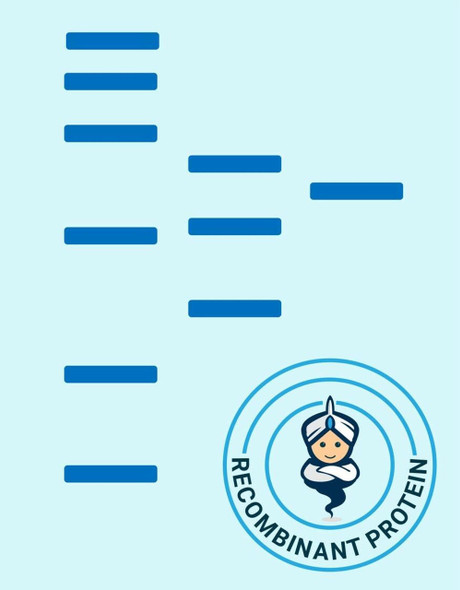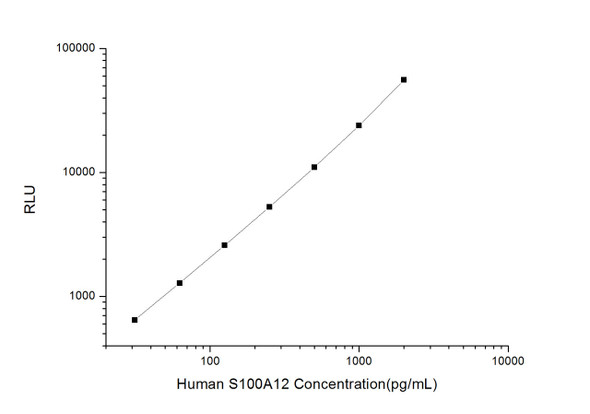Human S100A12 Recombinant Protein (RPPB4549)
- SKU:
- RPPB4549
- Product Type:
- Recombinant Protein
- Species:
- Human
- Uniprot:
- P80511
Description
| Product Name: | Human S100A12 Recombinant Protein |
| Product Code: | RPPB4549 |
| Size: | 10µg |
| Species: | Human |
| Target: | S100A12 |
| Synonyms: | Extracellular newly identified RAGE-binding protein, Protein S100-A12, CGRP, Calcium-binding protein in amniotic fluid 1, CAAF1, Calgranulin-C, CAGC, EN-RAGE, Neutrophil S100 protein, S100 calcium-binding protein A12, p6, S100A12, MRP6, ENRAGE. |
| Source: | Escherichia Coli |
| Formulation: | S100A12 was filtered (0.4 �m) and lyophilized in 0.5 mg/ml in 20mM Tris and 50mM NaCl, pH 7.5. |
| Solubility: | It is recommended to add deionized water to prepare a working stock solution of approximately 0.5 mg/ml and let the lyophilized pellet dissolve completely. Product is not sterile! Please filter the product by an appropriate sterile filter before using it in the cell culture. |
| Stability: | Store lyophilized protein at -20°C. Aliquot the product after reconstitution to avoid repeated freezing/thawing cycles. Reconstituted protein can be stored at 4°C for a limited period of time; it does not show any change after two weeks at 4°C. |
| Amino Acid Sequence: | MKHHHHHHAS TKLEEHLEGI VNIFHQYSVR KGHFDTLSKG ELKQLLTKEL ANTIKNIKDK AVIDEIFQGL DANQDEQVDFQEFISLVAIA LKAAHYHTHK E |
S100A12 belongs to the S100 family of proteins containing 2 EF-hand calcium-binding motifs. S100 family members are localized in the cytoplasm and/or nucleus of a wide range of cells, and are involved in the regulation of a number of cellular processes such as cell cycle progression and differentiation. S100A12 may be involved in specific calcium-dependent signal transduction pathways and its regulatory effect on cytoskeletal components may modulate various neutrophil activities.
The Recombinant Human S100A12 produced in E.coli has a molecular mass of 11.63kDa containing�101 amino acid residues of the human S100A12 and fused to a�10 a.a. His tag at N-terminus.
| UniProt Protein Function: | S100A12: S100A12 is a calcium-, zinc- and copper-binding protein which plays a prominent role in the regulation of inflammatory processes and immune response. Its proinflammatory activity involves recruitment of leukocytes, promotion of cytokine and chemokine production, and regulation of leukocyte adhesion and migration. Acts as an alarmin or a danger associated molecular pattern (DAMP) molecule and stimulates innate immune cells via binding to receptor for advanced glycation endproducts (AGER). Binding to AGER activates the MAP-kinase and NF-kappa-B signaling pathways leading to production of proinflammatory cytokines and up-regulation of cell adhesion molecules ICAM1 and VCAM1. Acts as a monocyte and mast cell chemoattractant. Can stimulate mast cell degranulation and activation which generates chemokines, histamine and cytokines inducing further leukocyte recruitment to the sites of inflammation. Can inhibit the activity of matrix metalloproteinases; MMP2, MMP3 and MMP9 by chelating Zn(2+) from their active sites. Possesses filariacidal and filariastatic activity. Calcitermin possesses antifungal activity against C.albicans and is also active against E.coli and P.aeruginosa but not L.monocytogenes and S.aureus. Belongs to the S-101 family. |
| UniProt Protein Details: | Chromosomal Location of Human Ortholog: 1q21 Cellular Component: cytoskeleton; cytoplasm; extracellular region; plasma membrane; nucleus; cytosol Molecular Function:protein binding; RAGE receptor binding; copper ion binding; zinc ion binding; calcium ion binding Biological Process: neutrophil chemotaxis; positive regulation of MAP kinase activity; monocyte chemotaxis; positive regulation of I-kappaB kinase/NF-kappaB cascade; killing of cells of another organism; xenobiotic metabolic process; defense response to bacterium; innate immune response; inflammatory response; defense response to fungus; mast cell activation; cytokine secretion; activation of NF-kappaB transcription factor; positive regulation of inflammatory response |
| NCBI Summary: | The protein encoded by this gene is a member of the S100 family of proteins containing 2 EF-hand calcium-binding motifs. S100 proteins are localized in the cytoplasm and/or nucleus of a wide range of cells, and involved in the regulation of a number of cellular processes such as cell cycle progression and differentiation. S100 genes include at least 13 members which are located as a cluster on chromosome 1q21. This protein is proposed to be involved in specific calcium-dependent signal transduction pathways and its regulatory effect on cytoskeletal components may modulate various neutrophil activities. The protein includes an antimicrobial peptide which has antibacterial activity. [provided by RefSeq, Nov 2014] |
| UniProt Code: | P80511 |
| NCBI GenInfo Identifier: | 2507565 |
| NCBI Gene ID: | 6283 |
| NCBI Accession: | P80511.2 |
| UniProt Related Accession: | P80511 |
| Molecular Weight: | |
| NCBI Full Name: | Protein S100-A12 |
| NCBI Synonym Full Names: | S100 calcium binding protein A12 |
| NCBI Official Symbol: | S100A12�� |
| NCBI Official Synonym Symbols: | p6; CAGC; CGRP; MRP6; CAAF1; MRP-6; ENRAGE�� |
| NCBI Protein Information: | protein S100-A12 |
| UniProt Protein Name: | Protein S100-A12 |
| UniProt Synonym Protein Names: | CGRP; Calcium-binding protein in amniotic fluid 1; CAAF1; Calgranulin-C; CAGC; Extracellular newly identified RAGE-binding protein; EN-RAGE; Migration inhibitory factor-related protein 6; MRP-6; p6; Neutrophil S100 protein; S100 calcium-binding protein A12Calcitermin |
| UniProt Gene Name: | S100A12�� |
| UniProt Entry Name: | S10AC_HUMAN |








